Archive for the ‘H Höch’ Category
Tuesday, July 26th, 2022
“We make a living by what we get;
we make a life by what we give.”
— Winston Curchill
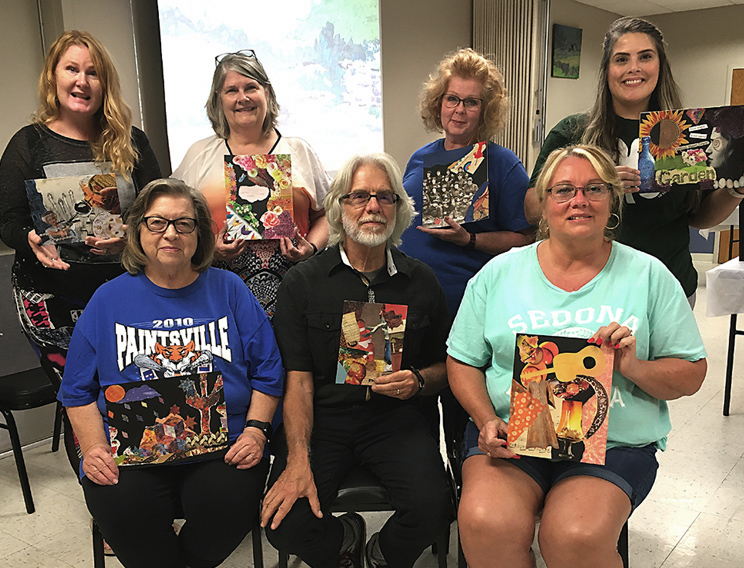 I’m still feeling a satisfying vibe from one of the most personally rewarding events ever! My hands-on collage workshop was part of the “Train the Trainer“ series in Paintsville, Kentucky for the Johnson County Extension Office. Participating artists intend to share this learning throughout their community in the coming months. My thanks to a fabulous group of creative individuals who were curious about “all things collage” and inspired to “pay it forward” among fellow citizens in their beautiful area of our Commonweath.
I’m still feeling a satisfying vibe from one of the most personally rewarding events ever! My hands-on collage workshop was part of the “Train the Trainer“ series in Paintsville, Kentucky for the Johnson County Extension Office. Participating artists intend to share this learning throughout their community in the coming months. My thanks to a fabulous group of creative individuals who were curious about “all things collage” and inspired to “pay it forward” among fellow citizens in their beautiful area of our Commonweath.
After an opening presentation with my whirlwind tour through over 200 years of collage history, a demonstration offered cutting tips, the basics of pasting technique, an overview of translucency and transfers, plus an emphasis on maintaining the flow of improvisational layering. (See my end-result demo piece below.) Throughout the day we stressed the fundamentals of visual aesthetics, while keeping our focus on intuitive spontaneity within an experimental process. Tables cluttered with potential ingredients were the norm, as participants tackled three time-based exercises and produced a collage miniature for each. Their well-crafted, colorful solutions were the take-home product, and we managed to fit in a closing discussion full of important observations. I was impressed with the group’s talent, curiosity, and spirit of creative adventure! It was an astonishing thing for me to observe how fluently they attuned to the vocabulary of collage expression, having no prior awareness of Hannah Höch, Joseph Cornell, or the Merz of Kurt Schwitters.
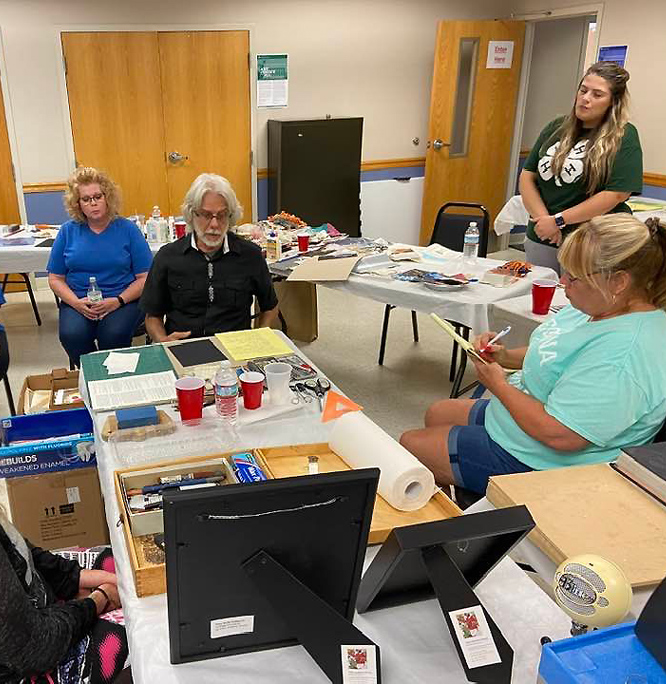
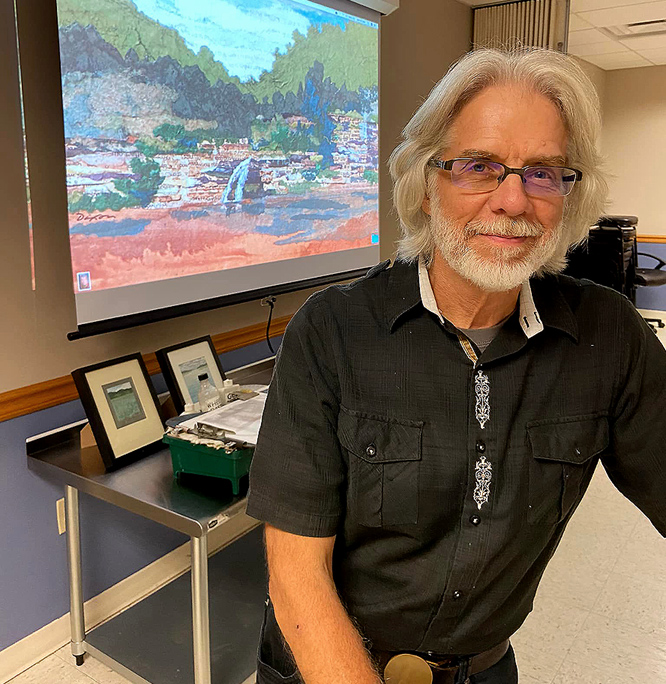

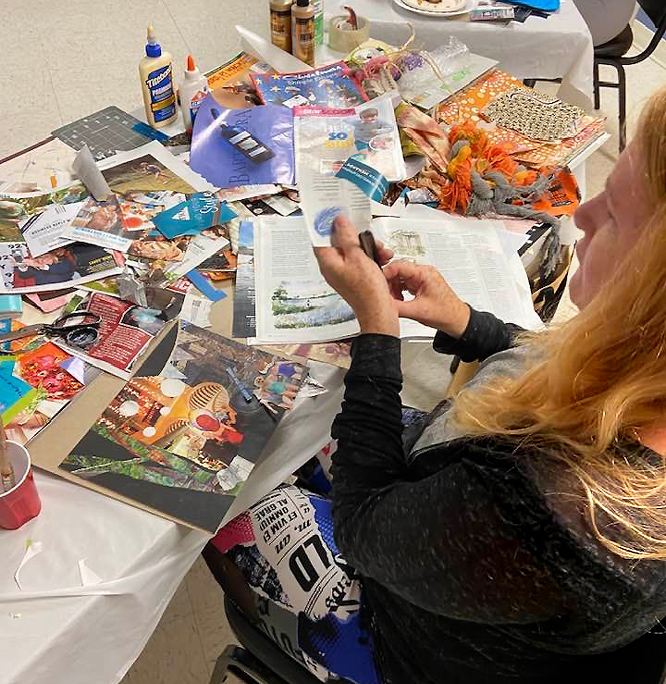
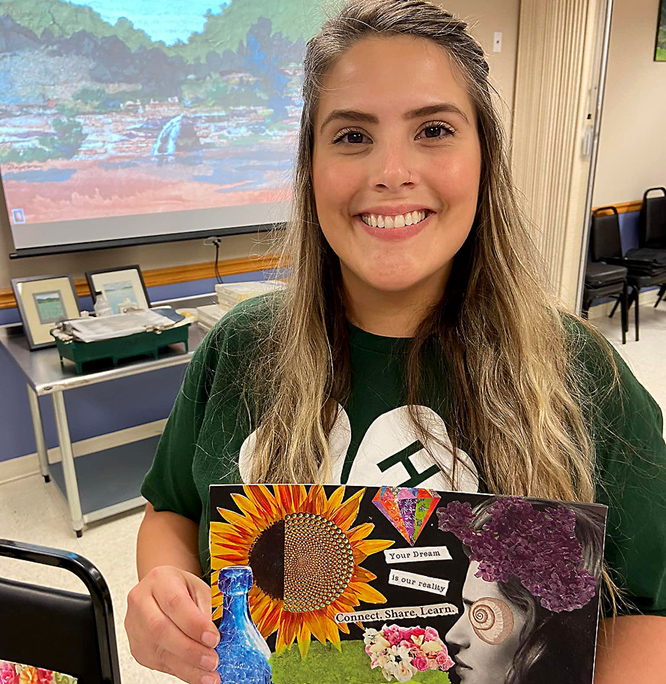

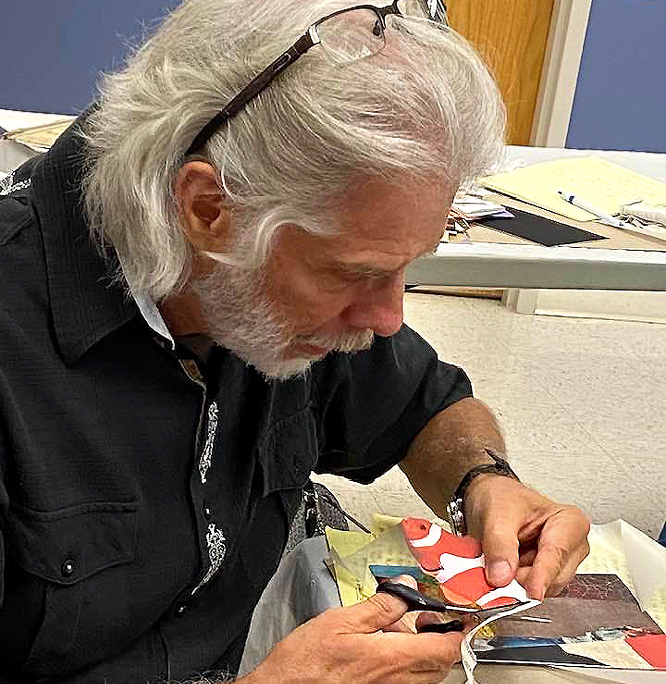
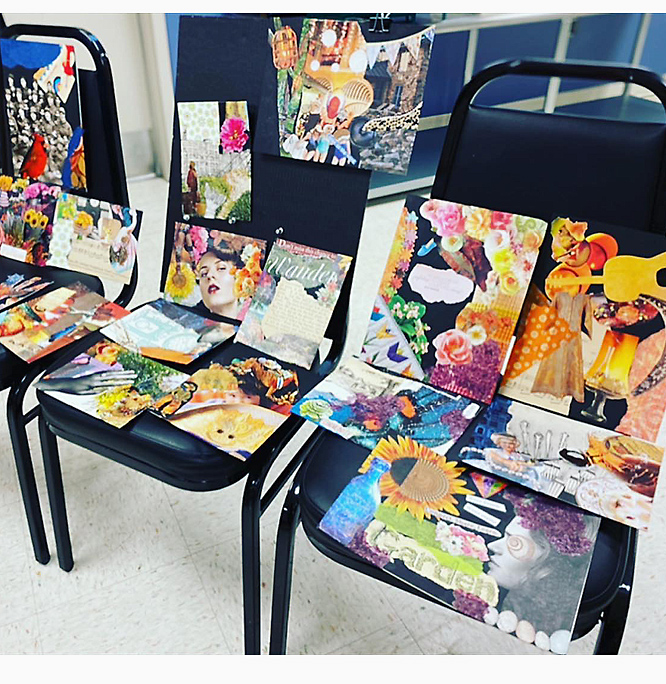

It’s been a while since I accepted the role of teacher. I was surprised and concerned to discover that it was no longer within my “comfort zone.” I faced a gauntlet of self-assurance to run before I felt prepared. The delightful, encouraging Brenda Cockerham, our project leader, provided vital support. As ever, Dana was an indispensable “partner in all things.” Why must I periodically be reminded that giving back is every bit as significant as anything I get from my artistic practice? I’m a fortunate man, because cutting and pasting offers a universal experience that is effortless to share with others — if I just get out of my own way. Collage at all levels presents an ideal opportunity for individual receptivity. It’s rewarding to watch this sense of discovery, similar to what I experience myself as I explore the wide potential of art made from paper that would otherwise be cast away. This connection with others fires my enthusiasm to compile additional collage insights and to continue passing them along. There is much to gain within a shared creative environment when we take discarded stuff and create value where none existed, and find wonder, meaning, and beauty where none had been expected.
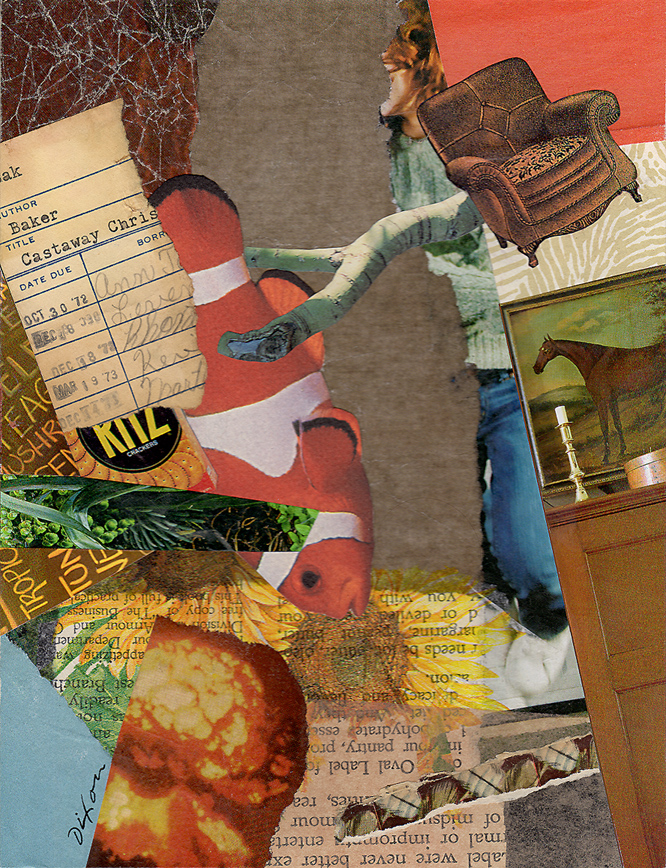
Don’t Clown Around
collage experiment by J A Dixon
created during my workshop demonstration
6.5 x 8.5 inches
Posted in Collaboration, Constraints, Demonstrations, Events, Experiments, H Höch, Influences, Ingredients, J Cornell, K Schwitters, Merz, Technique | No Comments »
Tuesday, August 21st, 2018
“We do not analyze works of art because we want to imitate them or because we distrust them.”
— Paul Klee
The other day the world learned about an unpublished Ernest Hemingway short story. If there had not been a Mark Twain first, would literature know Hemingway’s writings at all? Could there have been an Isaac Asimov, Stan Lee, or Gene Wolfe without a Verne or Burroughs? The J.K. Rowling body of work without an Austen or Tolkien? 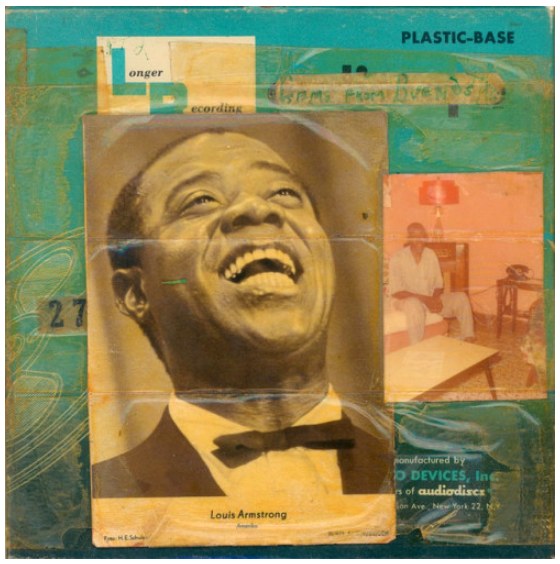 Similarly, all of today’s rock music can be linked to direct influences — to bands such as Ramones, Led Zeppelin or the Beatles, which, of course, had their own precursors. Would jazz exist in its current form without the innovations of Armstrong and all those who inspired him? Imagine a contemporary musician saying, “I really haven’t paid attention to any music that was recorded before I started to play.” And yet, not infrequently, collage artists will boast that they have little use for art history (all the breakthroughs of bygone creators who dug the swimming pools in which they now frolic).
Similarly, all of today’s rock music can be linked to direct influences — to bands such as Ramones, Led Zeppelin or the Beatles, which, of course, had their own precursors. Would jazz exist in its current form without the innovations of Armstrong and all those who inspired him? Imagine a contemporary musician saying, “I really haven’t paid attention to any music that was recorded before I started to play.” And yet, not infrequently, collage artists will boast that they have little use for art history (all the breakthroughs of bygone creators who dug the swimming pools in which they now frolic).
It is argued that modern artists were the first to decide that visual art would be about art, rather than subject matter. Nonsense. Art has always been about art, because it always has been structured on prior foundations. The idea that any artist can burst on the scene as an original is absurd. Nobody who comes out of early childhood with any level of awareness has not built an inventory of perceptions — countless images from the culture around them. Each of these individual influences involved creative activity based on another bank of stimuli, and so forth, back to the first proto-human who picked up a piece of charcoal to make interesting marks on a stone (and was probably knocked on the head by another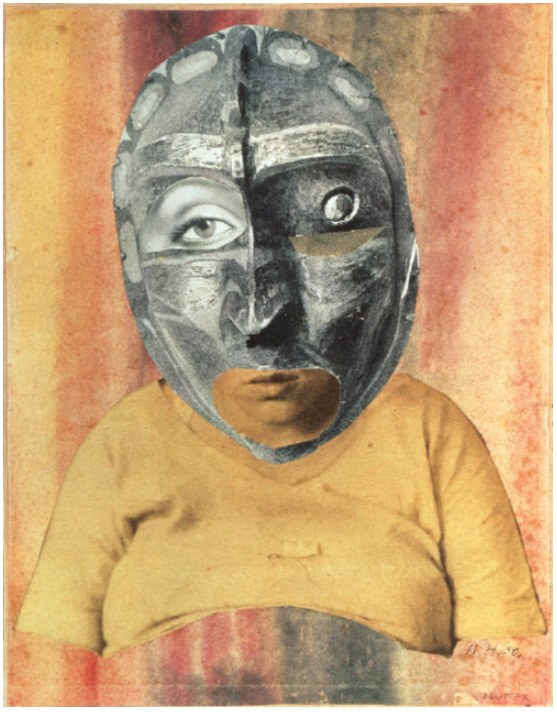
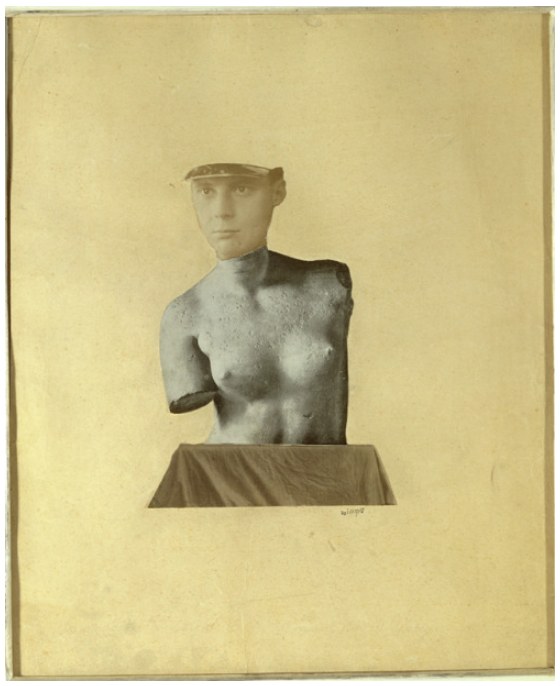 who judged the action as irrelevant to group survival).
who judged the action as irrelevant to group survival).
Perhaps I have belabored my point. Perhaps it is a point that anyone who reads this would not need emphasized in the first place. Isn’t it obvious to us that no art form is more about all these churning influences from untold visual decision makers — painters, printers, illustrators, photographers, designers — than the medium of collage itself? So, let us all continue to study the collage artworks of the explorers who came before us, to trace the direct lineage of their concepts and techniques, to recognize that valuable inheritance in the work of our peers, as well as in the composition taking shape on the surface before us, and then, fully informed, to push confidently into the second century of collage.
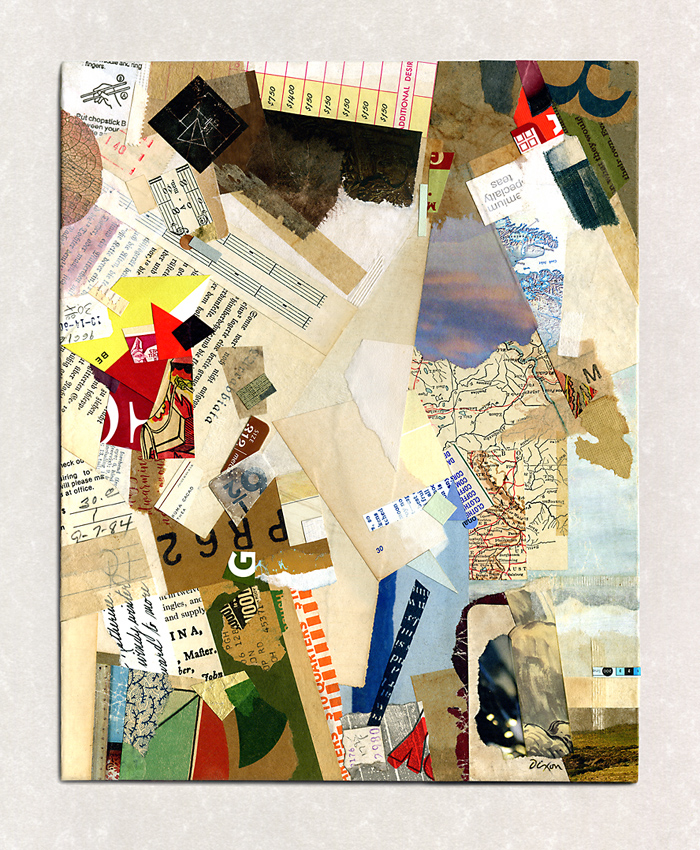
Tranquil Ode (to Merz)
collage homage by J A Dixon
9.5 x 11.875 inches
Purchase this artwork.
Posted in Abstraction, Applied Arts, Collage, Criticism, Cubism, Dada, Fluxus, Graphic Design, H Höch, Homage, Illustration, Influences, J A Dixon, J T Baargeld, K Schwitters, Literature, M Twain, Merz, Music, P Klee, Priorities, Surrealism | No Comments »
Tuesday, August 14th, 2018
“Against the assault of laughter, nothing can stand.”
— Mark Twain
The evolving medium of collage betrayed its sense of humor from the outset, over a hundred years ago. There are countless variants of humor — satire, sarcasm, incongruity, hyperbole, mild irony, outright farce — to cite merely a few.  Most, if not all, have presented themselves in a collage format during the tumultuous century that followed. From my point of view, the humor we may find in Dada and Surrealism are byproducts of the movements’ overarching goals. But, we might ask, was the avant-garde intending to be funny at times, or were they deadly serious about weaponizing shock value as a visual tactic, bequeathing any laughs to those of us who would arrive many decades later? On the other hand, how can poking fun at established traditions and ideologies not be classified as humor? I welcome the thoughts of all readers who have chuckled at the work of Hannah Höch, or sensed dark amusement in a Max Ernst composition. Even when outrage from a target group is the primary objective, a subversive artist also may be hoping to elicit a humorous response from those of like mind. As we know, humor, like beauty, rests in the eye of the beholder.
Most, if not all, have presented themselves in a collage format during the tumultuous century that followed. From my point of view, the humor we may find in Dada and Surrealism are byproducts of the movements’ overarching goals. But, we might ask, was the avant-garde intending to be funny at times, or were they deadly serious about weaponizing shock value as a visual tactic, bequeathing any laughs to those of us who would arrive many decades later? On the other hand, how can poking fun at established traditions and ideologies not be classified as humor? I welcome the thoughts of all readers who have chuckled at the work of Hannah Höch, or sensed dark amusement in a Max Ernst composition. Even when outrage from a target group is the primary objective, a subversive artist also may be hoping to elicit a humorous response from those of like mind. As we know, humor, like beauty, rests in the eye of the beholder.
Eduardo Paolozzi created his whimsical Bunk! collage series in 1947. During that same year, Kurt Schwitters, 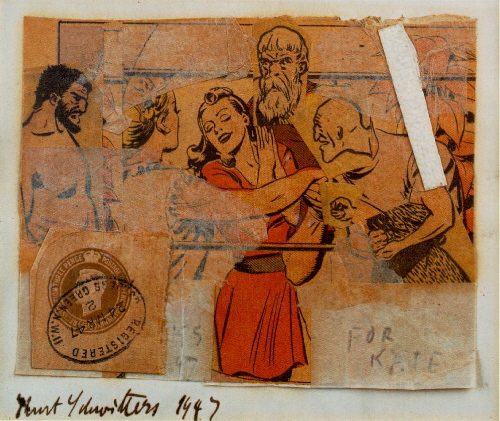 with the bulk of his far-reaching breakthroughs behind him, displayed his acknowledged sense of humor when he created “For Kate.” Both were envisioning the coming thing — Pop Art (Popism) — a movement to throttle the contemporary scene some 20 years later. Steve Martin got it right when he explained, “Chaos in the midst of chaos isn’t funny, but chaos in the midst of order is.” Did Mark Twain anticipate a Mel Brooks and how the art of stimulating laughter could enable a towering denunciation of fascism? Are there times when creativity’s greatest power is best unlocked with a joke?
with the bulk of his far-reaching breakthroughs behind him, displayed his acknowledged sense of humor when he created “For Kate.” Both were envisioning the coming thing — Pop Art (Popism) — a movement to throttle the contemporary scene some 20 years later. Steve Martin got it right when he explained, “Chaos in the midst of chaos isn’t funny, but chaos in the midst of order is.” Did Mark Twain anticipate a Mel Brooks and how the art of stimulating laughter could enable a towering denunciation of fascism? Are there times when creativity’s greatest power is best unlocked with a joke?
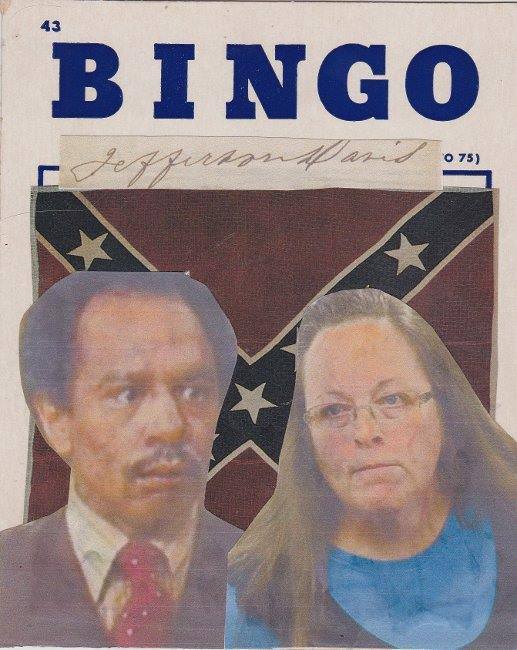 Now indulge me as I feature a few examples of humor in collage from artists that have touched my funny bone. I must admit that this subject brings to mind Terry R Flowers, perennial wit in the art form. It would be too easy to fill a screen with an array of his artistic wisecracks, especially in his role as veteran collaborator with Robert Hugh Hunt.
Now indulge me as I feature a few examples of humor in collage from artists that have touched my funny bone. I must admit that this subject brings to mind Terry R Flowers, perennial wit in the art form. It would be too easy to fill a screen with an array of his artistic wisecracks, especially in his role as veteran collaborator with Robert Hugh Hunt.
Some of these practitioners rely on a minimalist, juxtapositional approach — a sort of comedic “one-liner” — while others evoke a wry quality with a more complex effect. Perhaps nothing is more subjective than humor, so let them speak for themselves.
You’re encouraged to bring others to my attention, and I’ll prepare a follow-up entry!
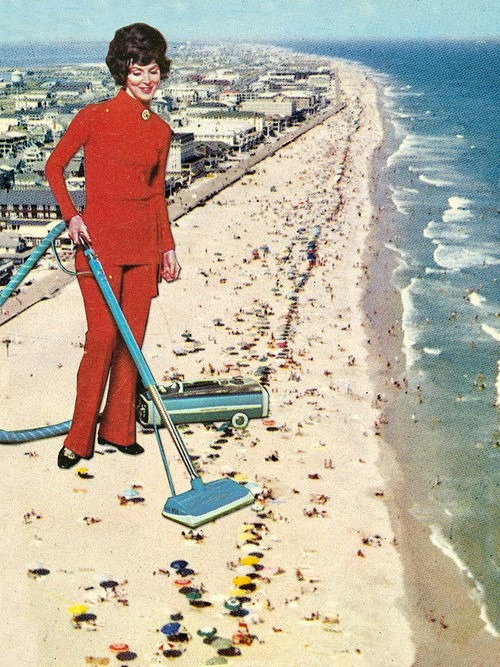
Eugenia Loli
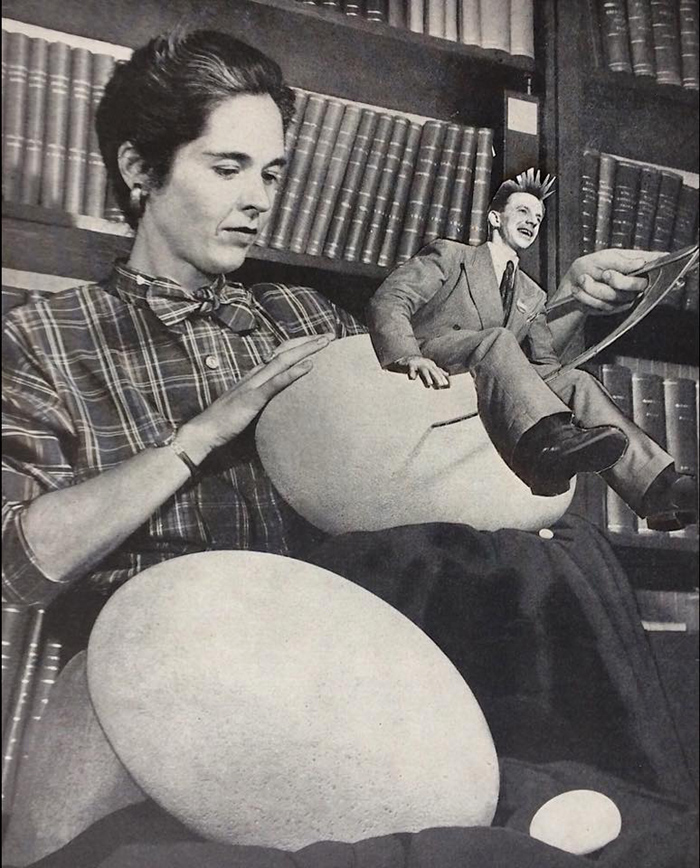
Susan Ringler
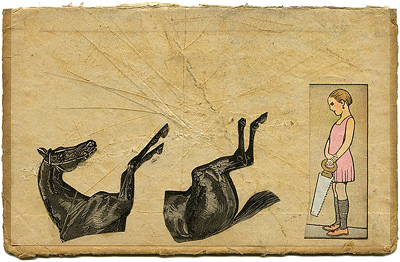
Dani Sanchis
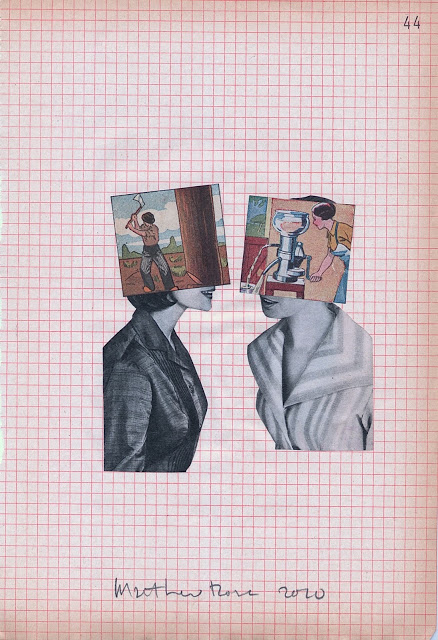
Matthew Rose
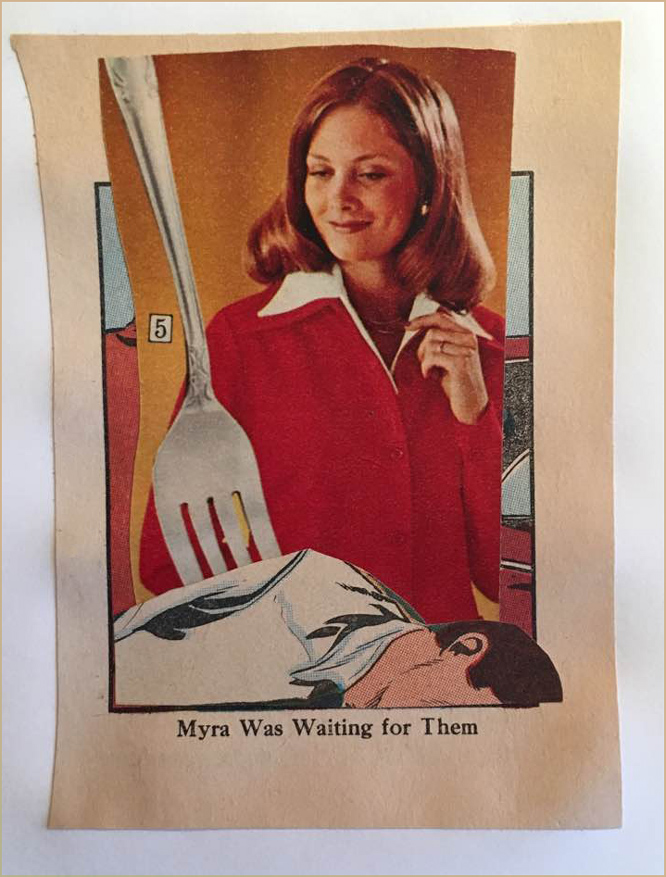
Bob Scott
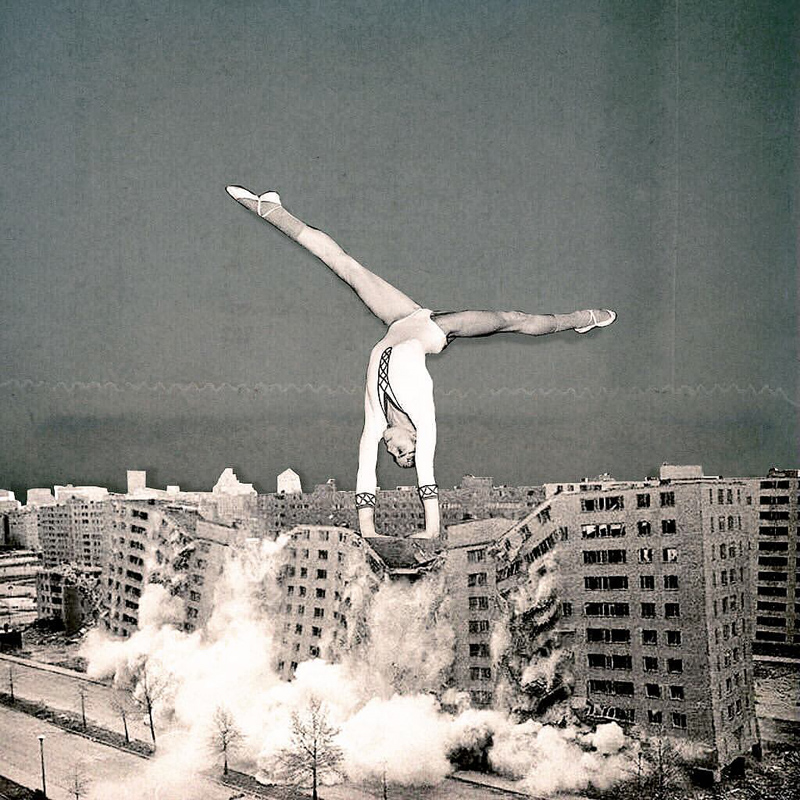
Sato Masahiro
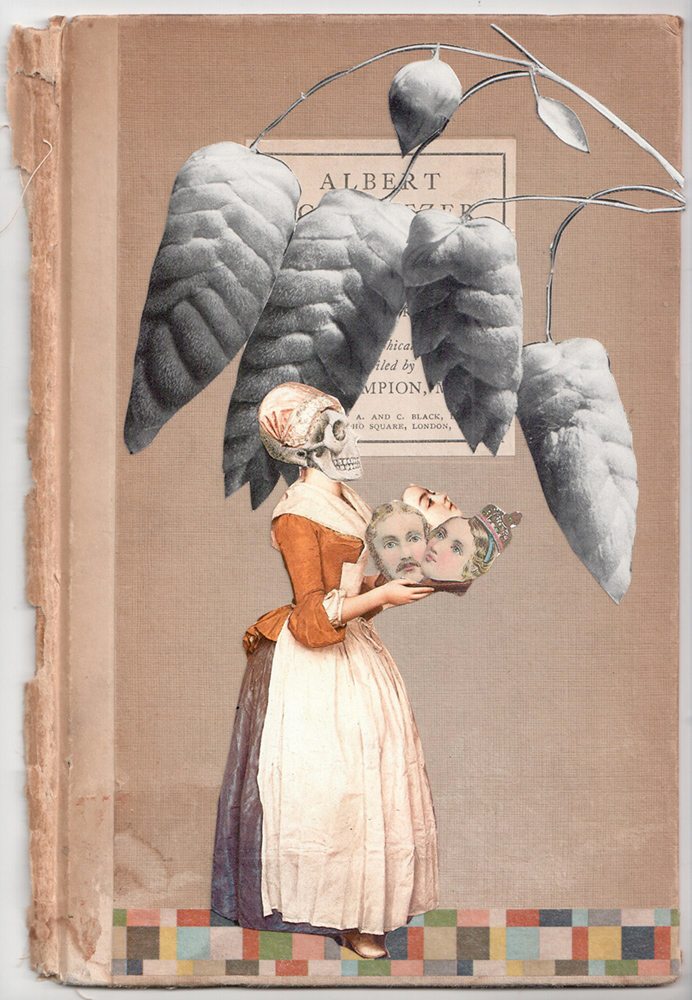
Sabine Remy
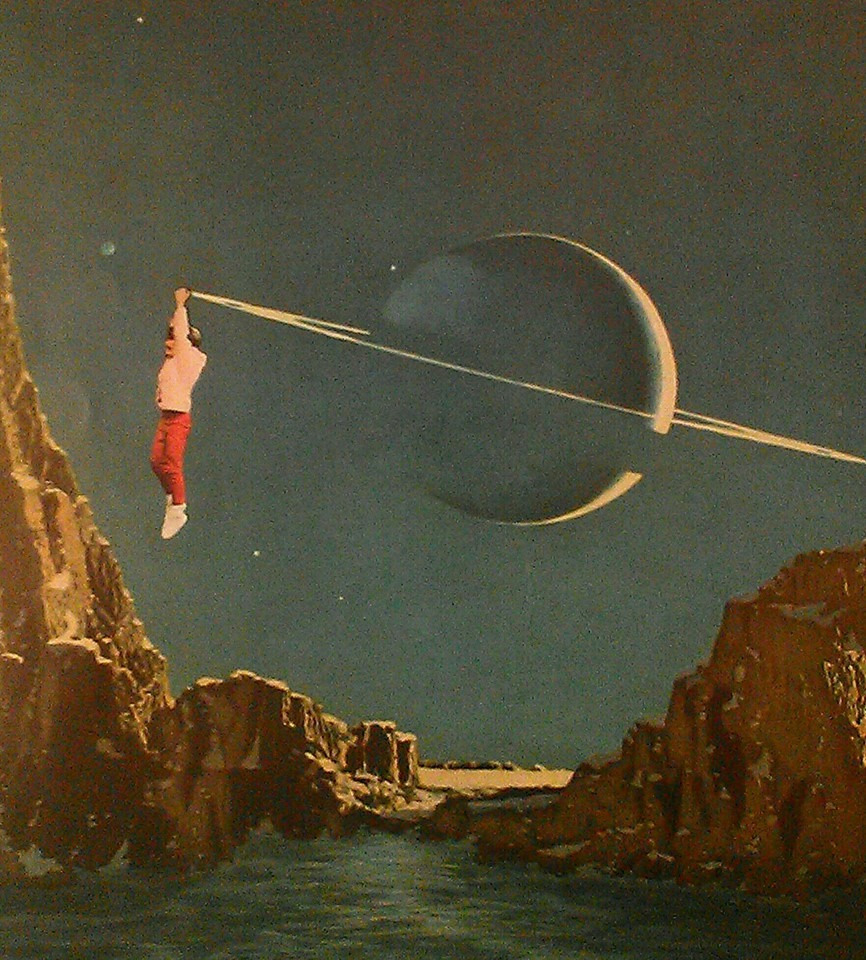
Raul Ruzzene
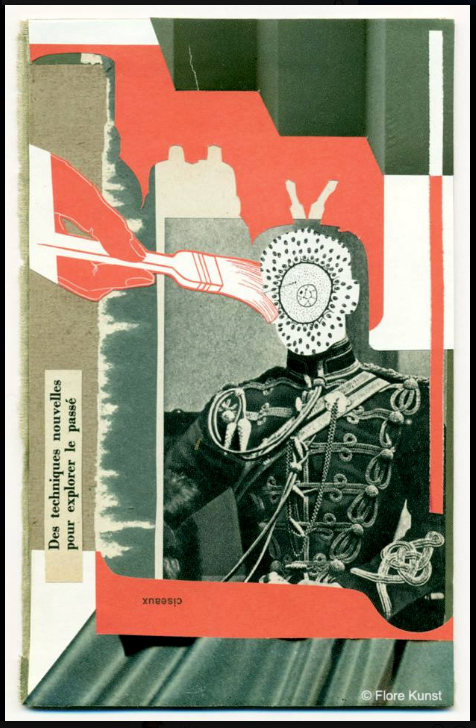
Flore Kunst
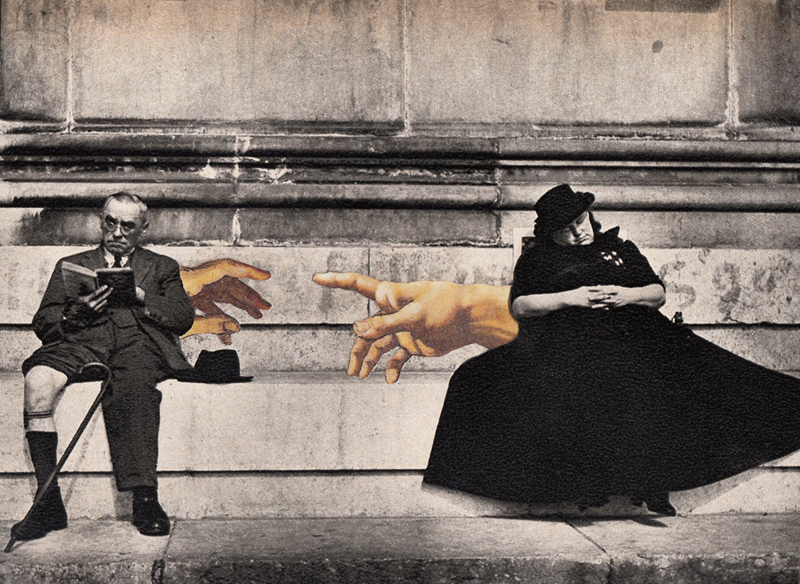
Terry R Flowers
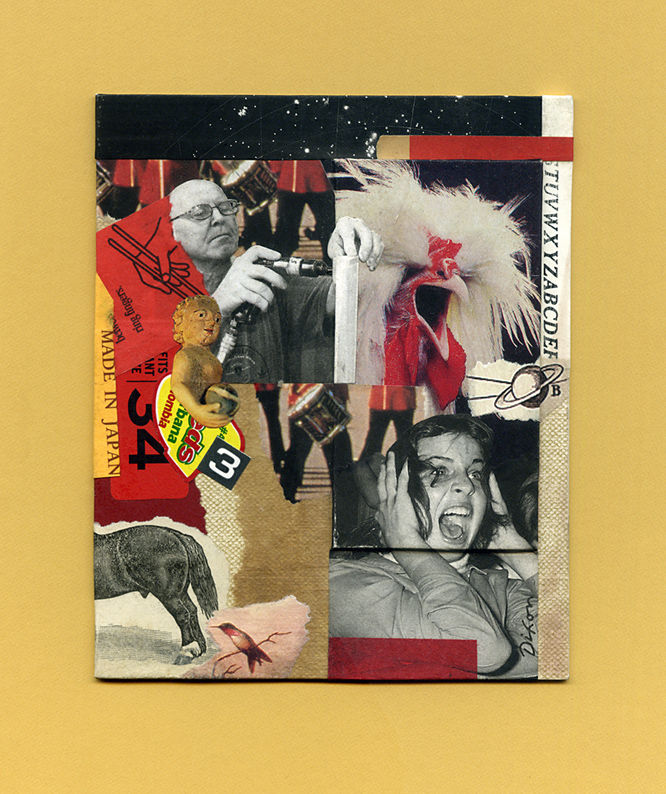
John Andrew Dixon ~ buy now
Posted in 1) Available!, B Scott, D Sanchis, E Loli, E Paolozzi, F Kunst, H Höch, J A Dixon, K Schwitters, M Brooks, M Ernst, M Rose, M Twain, R H Hunt, R Ruzzene, S Masahiro, S Remy, S Ringler, T R Flowers | No Comments »
Saturday, January 13th, 2018
“I have always tried to exploit the photograph. I use it like color, or as the poet uses the word.”
— Hannah Höch
It is always a temptation for a so-called blogger to dangle a “best of” or “top twenty” list to entice a visitor, and, of course, we see this tactic used almost on a daily basis in various fields of art and entertainment. How many of us have gone online and swallowed just such a colorful lure? On the most obvious level, the whole stimulus-response thing is a bit silly, but the potential to learn something new does exist, or to sharpen our own sense of quality, preference, and discernment. Each of us is free to have viewpoints, as long as we recognize them as personal opinions, and avoid casting them about as certitude. Isn’t there enough of that going on these days? (Yes, dear guest, that is merely my perspective.) 
What does this have to do with collage? Well, I just paid a visit to a page at AnotherMag.com (in response to the aforesaid bait), and I learned for the first time about three collage artists who were new to me, a working artist who purports to ruminate on “all things collage.” In this particular case, there may have been an explicit effort to achieve an overdue gender balance for a post intended to spotlight the Höch retrospective at the Whitechapel Gallery in London, but one could question the absence of Paolozzi, Rauschenberg, Johnson, Hamilton, or Kolář. To not include at least one of these men as a key figure in the history of collage brings no meaningful discredit on any of the artists, but only on the list. (And that, too, is just my opinion).
Nevertheless, I am not ashamed to accentuate the gaps in my collage literacy and to feature three noteworthy female artists: Eileen Agar, Nancy Spero, and Annegret Soltau. Examples of their work should have appeared here long before now.

Woman reading
by Eileen Agar, 1936
Museum of New Zealand

Protagonists
by Nancy Spero, 1989
disposition unknown

Grima – mit Katze
by Annegret Soltau, from her 1986-97 series
Vero Group Collection, Houston, Texas
Posted in A Soltau, Assemblage, Collage, Criticism, Dada, E Agar, E Paolozzi, Exhibitions, G Braque, H Höch, Influences, J Cornell, J Kolář, J Stezaker, J Treece, K Schwitters, Links, M Ray, Merz, N Spero, P Donley, R Hausmann, R Johnson, R Rauschenberg, Surrealism | No Comments »
Sunday, March 5th, 2017
“If you’re coasting, you’re going downhill.”
— L W Pierson
Awhile ago, someone asked a question about the trajectory of collage: “What’s Next?” To ponder that, I remind myself that one thoughtful critique is worth more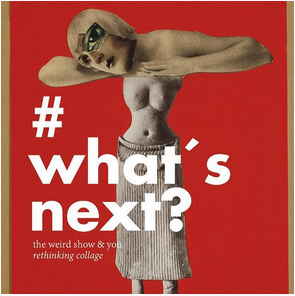 than a ton of casual “likes.” Those of us who love this practice need to push beyond the comfort of mutual praise and communicate honestly about the medium of collage (not about our political attitudes). Don’t expect the lords of social media to provide a thumbs-down button. That’s not the solution (even if they do). There needs to be the virtual equivalent of the intense coffee houses and night spots of a century ago, where artists were not shy about challenging the easy answers and safe solutions.
than a ton of casual “likes.” Those of us who love this practice need to push beyond the comfort of mutual praise and communicate honestly about the medium of collage (not about our political attitudes). Don’t expect the lords of social media to provide a thumbs-down button. That’s not the solution (even if they do). There needs to be the virtual equivalent of the intense coffee houses and night spots of a century ago, where artists were not shy about challenging the easy answers and safe solutions.
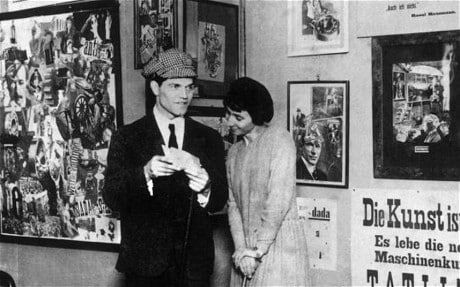 Höch, Hausmann, Schwitters, and their fellow collage “inventors” included found material contemporary with their times. There are many current practitioners who restrict themselves to “vintage” resources, and some of them avoid using anything younger than 50 years old. Whatever they choose to do is fine, but, in my opinion, 21st-century collage artists are challenged to explore the cast-off stuff of today for potential ingredients in a fresh “school of post-centennial collage” that “documents” our own culture, rather than confine themselves to curating the artifacts of our ancestors. Remember, when KS pasted down a tram ticket in place of a brushstroke, nearly a hundred years ago, he was clearly using something that he just acquired on the street. Let’s think about that when as ask ourselves, “What’s Next?”
Höch, Hausmann, Schwitters, and their fellow collage “inventors” included found material contemporary with their times. There are many current practitioners who restrict themselves to “vintage” resources, and some of them avoid using anything younger than 50 years old. Whatever they choose to do is fine, but, in my opinion, 21st-century collage artists are challenged to explore the cast-off stuff of today for potential ingredients in a fresh “school of post-centennial collage” that “documents” our own culture, rather than confine themselves to curating the artifacts of our ancestors. Remember, when KS pasted down a tram ticket in place of a brushstroke, nearly a hundred years ago, he was clearly using something that he just acquired on the street. Let’s think about that when as ask ourselves, “What’s Next?”
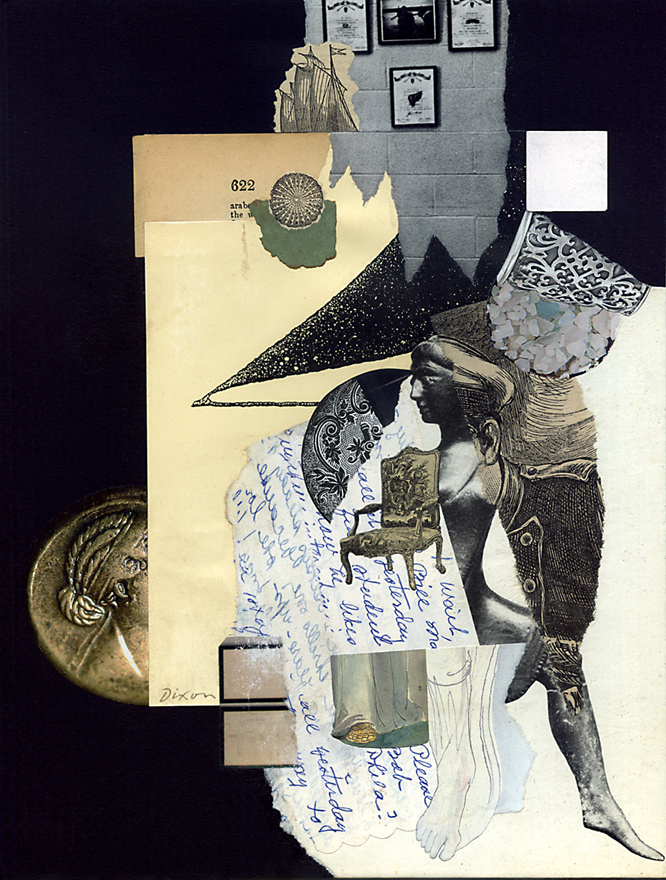
Tinged By Whispered Accounts
collage experiment in monochrome by J A Dixon
7.75 x 10.25 inches
Purchase this artwork.
Posted in Collage, Criticism, Dada, Experiments, H Höch, Ingredients, J A Dixon, K Schwitters, Merz, R Hausmann | No Comments »
Sunday, June 12th, 2016
“Nobody knows, and it is now too late to discover, who invented that most succinct of all art movement names.”
— Robert Hughes
“Style is not to be trusted.”
— Milton Glaser
As most of you know, 2016 marks the centennial of the art movement known as Dada. Although credit for originating collage is customarily granted to the Cubists, nobody shaped the emerging medium as powerfully as early 20th-Century Dadaists and their successors, the Surrealists. Very few traditions or conceptual approaches in contemporary collage have not navigated the tributaries they established, in spite of the fact that each of these artistic “schools of thought” had a relatively short apex. Much continues to be said and written about the catalytic Hugo Ball and the seismic effect after he opened Zurich’s Cabaret Voltaire with Emmy Hennings in February, 1916. Most of the work still being created under the banner of collage has not escaped the hundred-year shadow of inherent sensibilities unleashed on modern art by those who first uttered “Dada!” — spontaneity, chance, irreverence, consternation, and, perhaps foremost, a rejectionist posture. Without a doubt, most collage artists of our time would disagree with Ball’s exhortation to “burn all libraries and allow to remain only that which everyone knows by heart.” Nevertheless, they might indeed relate to his conclusion that “this humiliating age has not succeeded in winning our respect.”
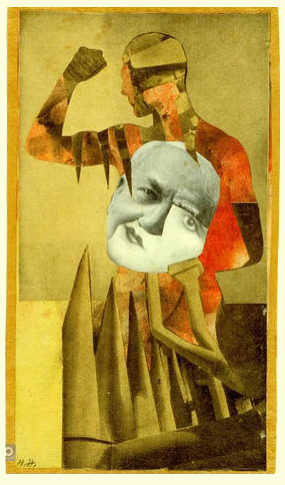 Warsaw-based designer/educator and blogger Annę Kłos describes Dada as a world view, that by its very nature could not be homogeneous, and that the seminal Merz of Kurt Schwitters was manifest within the context of internal incompatibilities. For the most part, however, many artists now tend to lump together the Dadaists, and emulate their visual and intellectual departures as an encompassing genre at best and a mere “style” at worst. — Time out. — This is when I grab myself by the scruff of the neck to keep from going off on an unnecessary tangent. My purpose is to share an ongoing fascination with how Dada continues to influence those of us working in the medium today. Permit me to highlight one particular “subject” that shows no sign of diminishing — the enduring exploration of the Surreal Face. René Magritte’s Le fils de l’homme immediately comes to mind (or his much earlier cover image for André Breton’s Qu’est-ce que le surréalisme?). One must follow their roots to Dada, and to the photomontages of Raoul Hausmann and Hannah Höch, (or her The Strong Guys, or his Tatlin at Home). For me, nothing exemplifies the unsettling, elusive qualities of the Dada phenomenon better than when a contemporary collage virtuoso captures that inexpressible twist of incongruity and aesthetic finesse with a surreal take on the human head. Just when I think there is nothing more to be tapped, I appreciate anew how inexhaustible this “renewable resource” can be.
Warsaw-based designer/educator and blogger Annę Kłos describes Dada as a world view, that by its very nature could not be homogeneous, and that the seminal Merz of Kurt Schwitters was manifest within the context of internal incompatibilities. For the most part, however, many artists now tend to lump together the Dadaists, and emulate their visual and intellectual departures as an encompassing genre at best and a mere “style” at worst. — Time out. — This is when I grab myself by the scruff of the neck to keep from going off on an unnecessary tangent. My purpose is to share an ongoing fascination with how Dada continues to influence those of us working in the medium today. Permit me to highlight one particular “subject” that shows no sign of diminishing — the enduring exploration of the Surreal Face. René Magritte’s Le fils de l’homme immediately comes to mind (or his much earlier cover image for André Breton’s Qu’est-ce que le surréalisme?). One must follow their roots to Dada, and to the photomontages of Raoul Hausmann and Hannah Höch, (or her The Strong Guys, or his Tatlin at Home). For me, nothing exemplifies the unsettling, elusive qualities of the Dada phenomenon better than when a contemporary collage virtuoso captures that inexpressible twist of incongruity and aesthetic finesse with a surreal take on the human head. Just when I think there is nothing more to be tapped, I appreciate anew how inexhaustible this “renewable resource” can be.
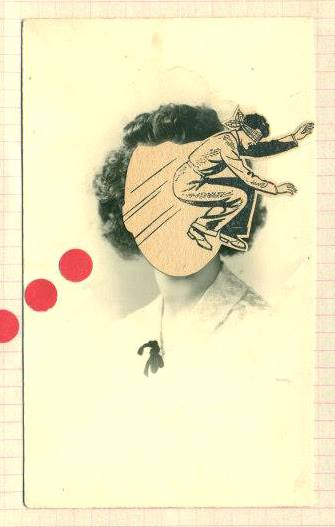
Flore Kunst
From her extraordinary “sketchbook” (Page 1).
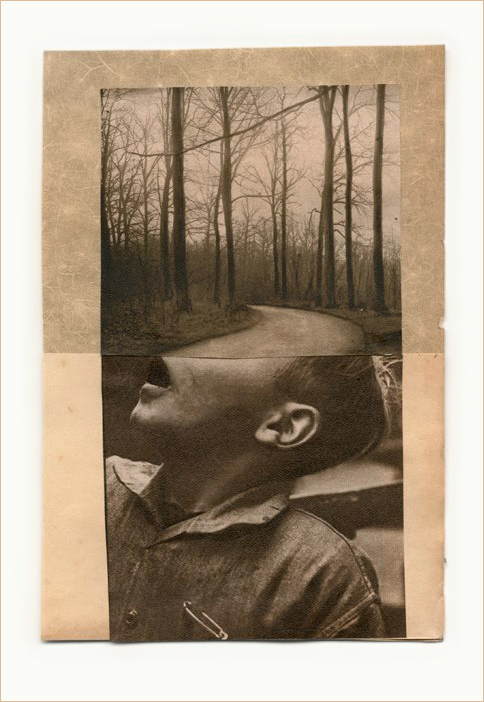
Katrien De Blauwer
From her Loin Series. Does anyone else do more with less?
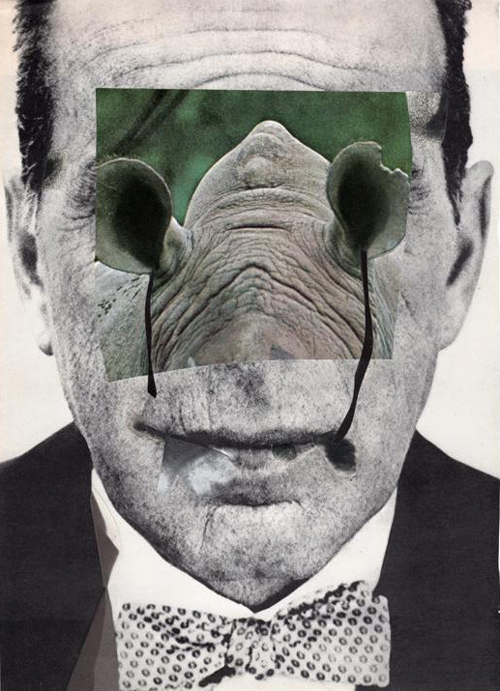
Charles Wilkin
“For me clarity and relief is found solely through the process itself.”
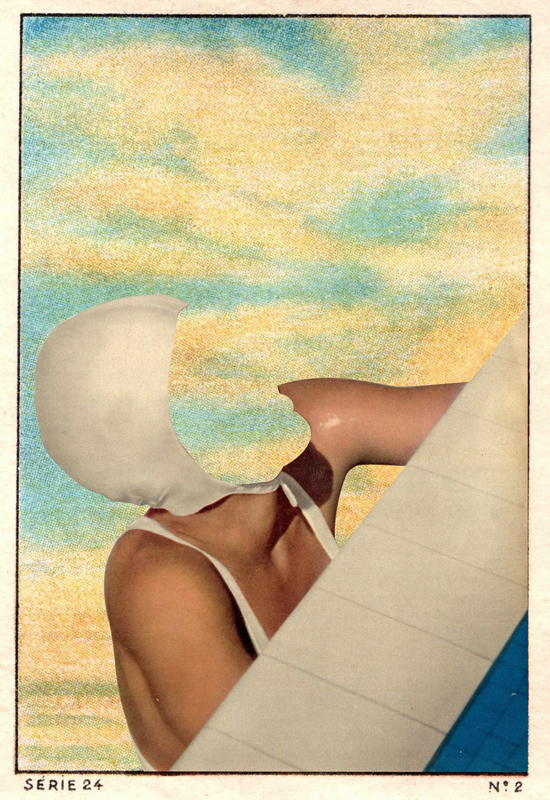
Peggy Despres
The prolific Peggy Pop will find the sweet spot.
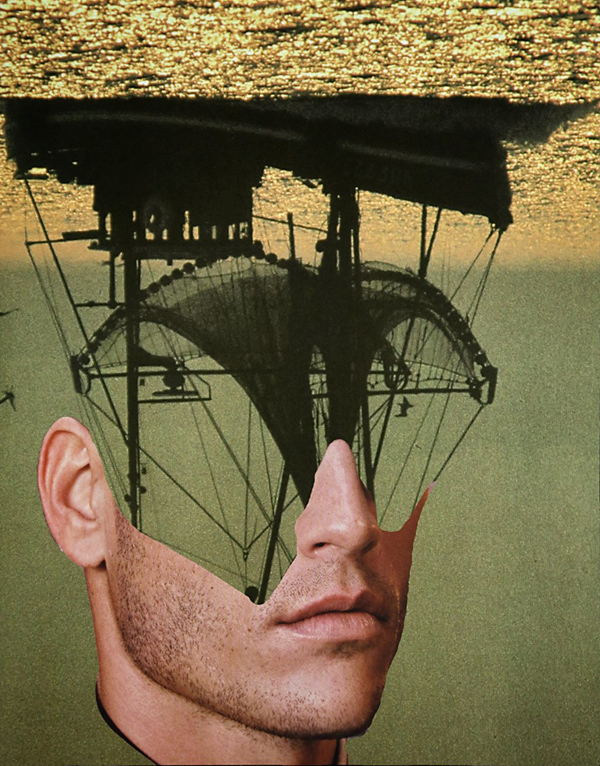
Pascal Verzijl
Never Saw It Coming (Did Dadaists see digital collage coming?)
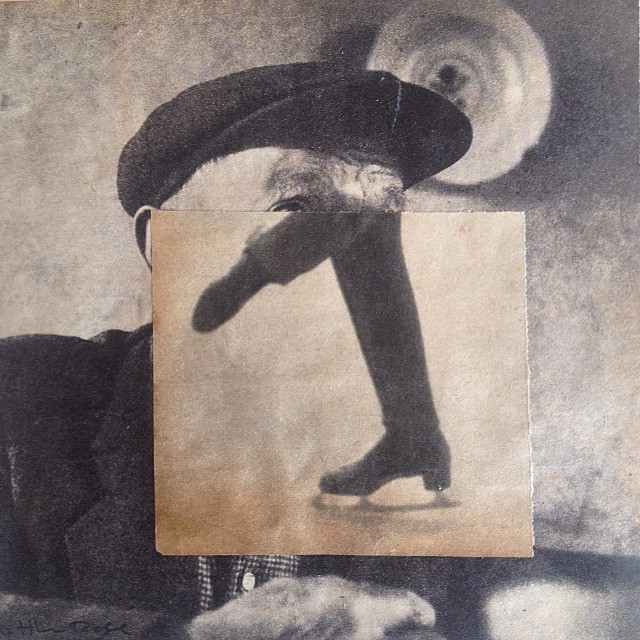
Matthew Rose
My Advice (What would I actually give to get his advice?)
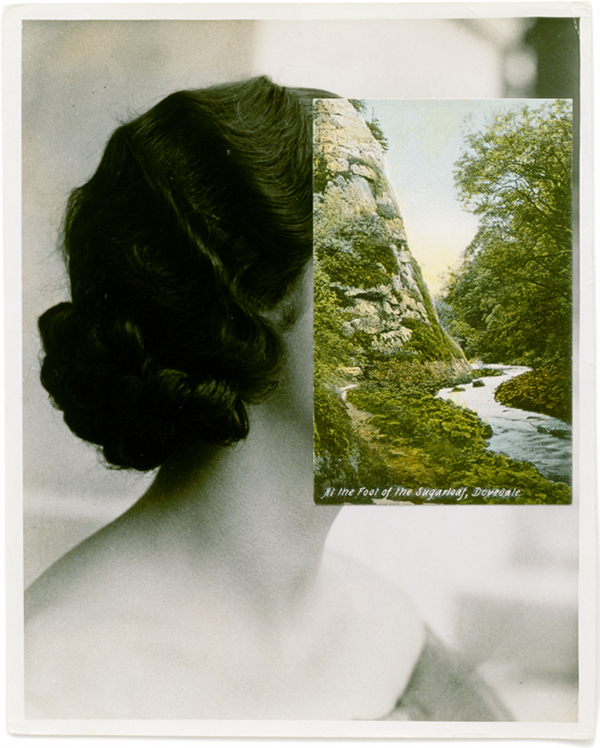
John Stezaker
“It sometimes feels like I am cutting though flesh.”
Posted in C Wilkin, Dada, F Kunst, H Höch, J Stezaker, K De Blauwer, K Schwitters, M Glaser, M Rose, P Despres, P Verzijl, R Hausmann, R Magritte, Surrealism | No Comments »
Monday, February 29th, 2016
Friend and fellow collage artist Kathleen O’Brien is in the midst of her countdown to a big solo show in April. She asked me to do a favor and share a guest review as part of her final promotions for JUXTAPOSE before Drawn to the Earth requires her full concentration. As excited as I am about the group exhibition in Danville, it was a tougher post to write than I first anticipated. Collage is not the easiest art form on which to expound, perhaps because it relies on the “logic” of irrational choices.
At any rate, my dedicating a blogsite to that very topic was nobody else’s idea, so I best not complain to those of you kind enough to visit here. Would I rather be making art? Of course. Even so, I cannot constrain my enthusiasm for all things collage. Here’s my take on a great show. Be forewarned: If you’re looking for some criticism, you won’t find it!
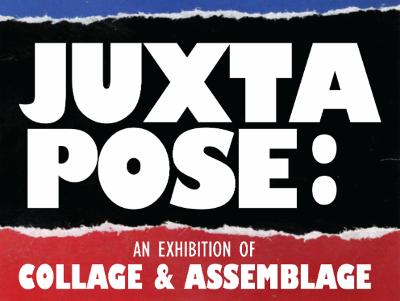


I’ll admit it. I can’t get enough of JUXTAPOSE. The current exhibition of collage and assemblage is at the Community Arts Center until April 2nd. That’s not exactly the most humble thing to say, considering it features a dozen works by yours truly, so I won’t pretend that I can offer an unbiased review. Program director Brandon Long has organized a finely curated, must-see destination that brings together over a thousand examples of the two associated mediums (literally, but I’ll explain that in a moment). This is an unprecedented group show for the Bluegrass-based artists involved, and I am thrilled to be exhibiting side-by-side with Kathleen O’Brien, Teri Dryden, Robert Hugh Hunt, Meg Higgins, Connie Beale, Cynthia Carr, and many others. No doubt my enthusiasm has something to do with its location less than a city block from my studio, which bestows the luxury of repeated immersions, and there is over a month left in the duration!
There are more participants than I can profile individually, and far too many artworks to highlight. The best example of this is a room devoted to three complete year-long series of collage-a-day works by O’Brien, Long, and Nan Martindale. Combined with almost one hundred seventy of Robert Hugh Hunt’s provocative collage collaborations, the magnitude of miniature artworks presented in a single space could be overwhelming. As an exhibition designer, Long uses geometric grids, browsing boxes, and two flat-screen displays to make the huge collection comprehensible for viewers. O’Brien’s sensitive, meticulously layered collection of daily two-sided postcards is a journey to which I surrender with pleasure each time I visit, but only after a jolting romp through Hunt’s rarely exhibited Hillbilly Voodoo series with T R Flowers.
An opportunity to view works by six outstanding Louisville-based artists is worth the trip to Danville. Several major works by Meg Higgins captured my first impression. Two enormous pieces composed with transparent elements sandwiched between Plexiglas are suspended between the vestibule and grand gallery. I was equally impressed by a smaller collage on wood panel, Japanese Peony Goes to Italy, with its exquisite East-West flavor. Brad Devlin’s solid but clever exploitation of found objects yields bold abstractions that simultaneously maintain a strong environmental essence. His Open Sunday is also physically more complex than it first appears, and this allows the artisanship of his assemblage to become a secondary experience deserving of scrutiny. Masters of juxtaposition who reinforce the theme of the exhibition as well as anyone taking part, Patrick Donley, Lisa Austin and Brandon Bass each define a distinctive individual style. Approach to composition, color considerations, and a playful choice of ingredients form undercurrents that tie their pieces together, and Long knows how to modulate the walls in a way that makes groupings of their work satisfying to study. Although she has recently gained attention for her paintings, there are at least seven panels by Teri Dryden from a handsome body of work created from discarded books. Her Monteith’s Marrakesh exemplifies how her investigation successfully transcended the source material. Personally, I hope she rotates to collage again for another dynamic round of re-purposing cast-off items.
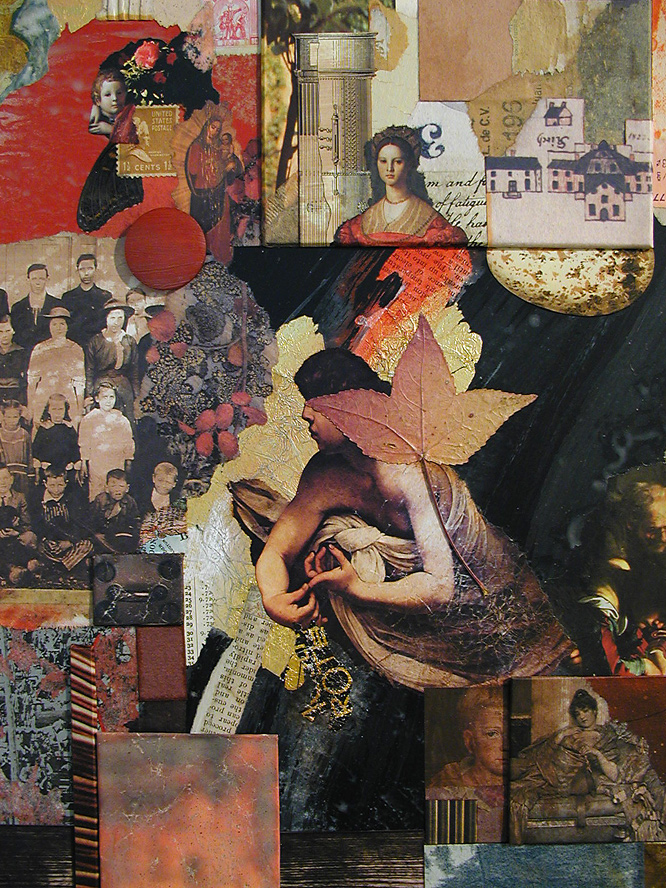 In addition to displaying a pair of shadow boxes, my only surrealist assemblage, and six favorite collage miniatures, JUXTAPOSE provides an opportunity to exhibit Bull’s-eye Nosegay for the first time, which I created for the Target Practice Project initiated by L T Holmes. Also, I did two larger collage artworks especially for this show. Each makes more than a fleeting nod to artists who I admire. What is it about Cherry Balm that causes me to think I just might be “tipping my beret” to the inimitable Matthew Rose? Reliquia is my tribute to the late Fred Otnes, a giant within the medium who has been a force in my consciousness since adolescence. Pearallelograms was held over from the previous exhibition at the institution, but the crowning delight for me may well be the presence of Kentucky Madonna, last year’s “finish” by Robert Hugh Hunt to my “start.” The collaborative piece is a companion to one currently hanging with the IT TAKES TWO exhibition of collaborations at the Kentucky Artisan Center in Berea. Robert and I can’t ask for more than to know that both are now available for public observation (unless someone wants to give them a good home).
In addition to displaying a pair of shadow boxes, my only surrealist assemblage, and six favorite collage miniatures, JUXTAPOSE provides an opportunity to exhibit Bull’s-eye Nosegay for the first time, which I created for the Target Practice Project initiated by L T Holmes. Also, I did two larger collage artworks especially for this show. Each makes more than a fleeting nod to artists who I admire. What is it about Cherry Balm that causes me to think I just might be “tipping my beret” to the inimitable Matthew Rose? Reliquia is my tribute to the late Fred Otnes, a giant within the medium who has been a force in my consciousness since adolescence. Pearallelograms was held over from the previous exhibition at the institution, but the crowning delight for me may well be the presence of Kentucky Madonna, last year’s “finish” by Robert Hugh Hunt to my “start.” The collaborative piece is a companion to one currently hanging with the IT TAKES TWO exhibition of collaborations at the Kentucky Artisan Center in Berea. Robert and I can’t ask for more than to know that both are now available for public observation (unless someone wants to give them a good home).
I am no art historian, but I can’t help but be mindful of the pioneering artists who laid a hundred-year foundation for the sweeping diversity of this exhibition. The creative innovations of Picasso, Braque, Duchamp, Schwitters, Höch, Cornell, Johnson, and Kolář reverberate throughout the building. In many respects, all contemporary collage/assemblage is a tacit homage to these seminal influences, but that is never the only thing at work nor the only phenomena to be perceived when one indulges an exhibition of this scope. Most artists are striving for a personal means of expression informed by those who have made their enduring mark on a medium. I am convinced, more than ever, that what distinguishes contemporary collage/assemblage artists is their keen connection to the mundane “stuff” of culture and the inner need to bring a measure of order and harmony from the sheer volume of material produced by our throw-away society, with its chaotic effect on our sensibilities — to create value where none exists, or to find wonder, meaning, significance, and beauty where none can be expected.
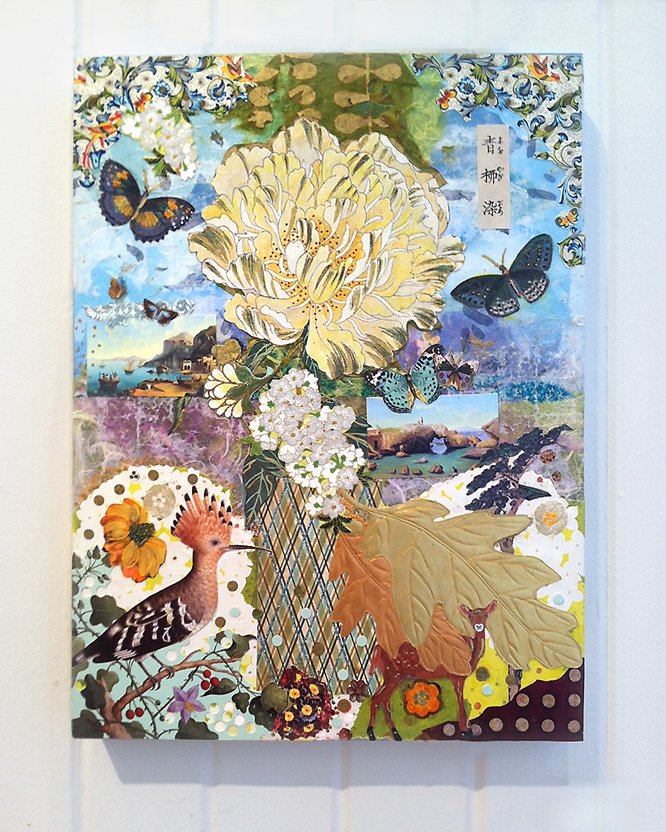
Japanese Peony Goes to Italy
Meg Higgins
collage on wood panel
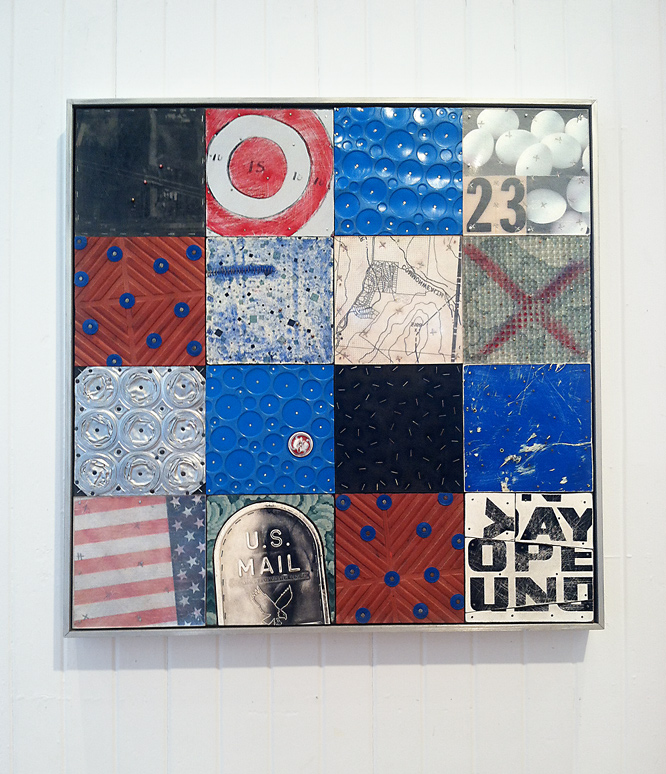
Open Sunday
Brad Devlin
assemblage, found objects
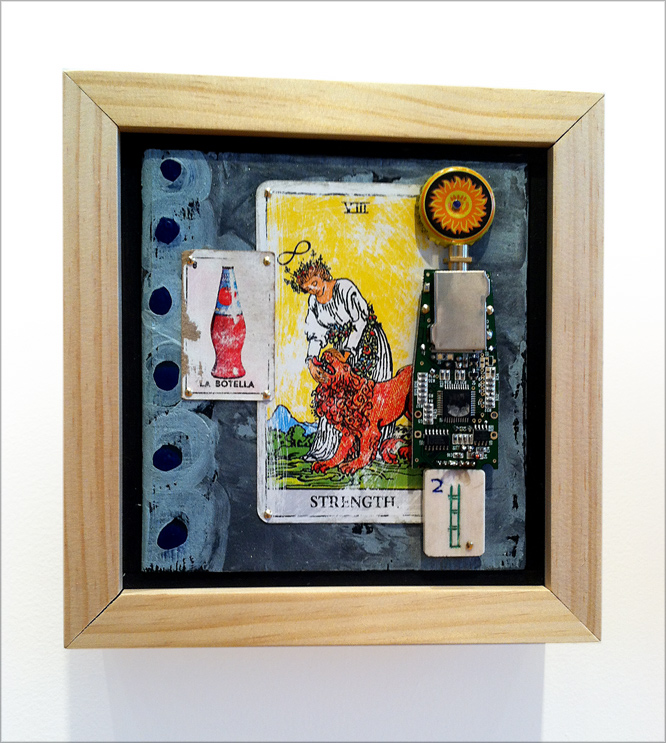
Strength
Patrick Donley
mixed-media on wood
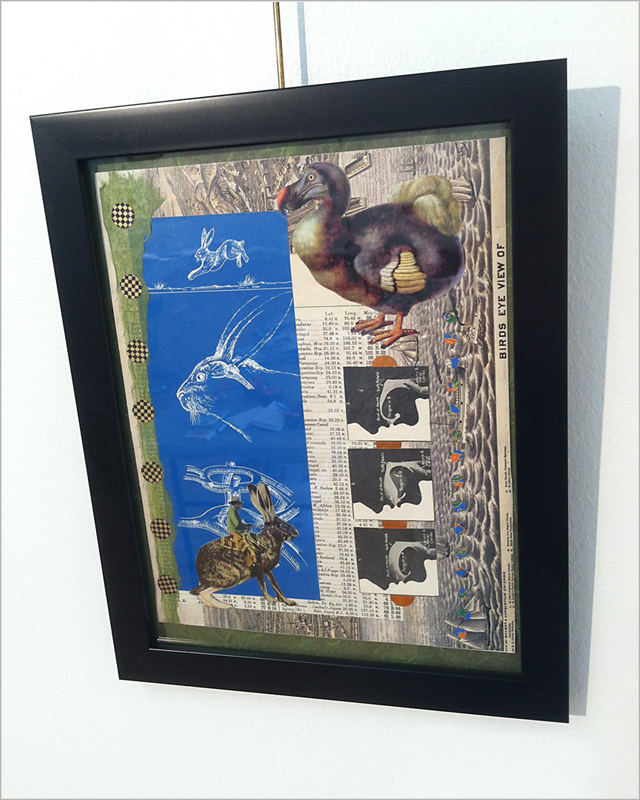
Bird’s Eye View
Lisa Austin
collage
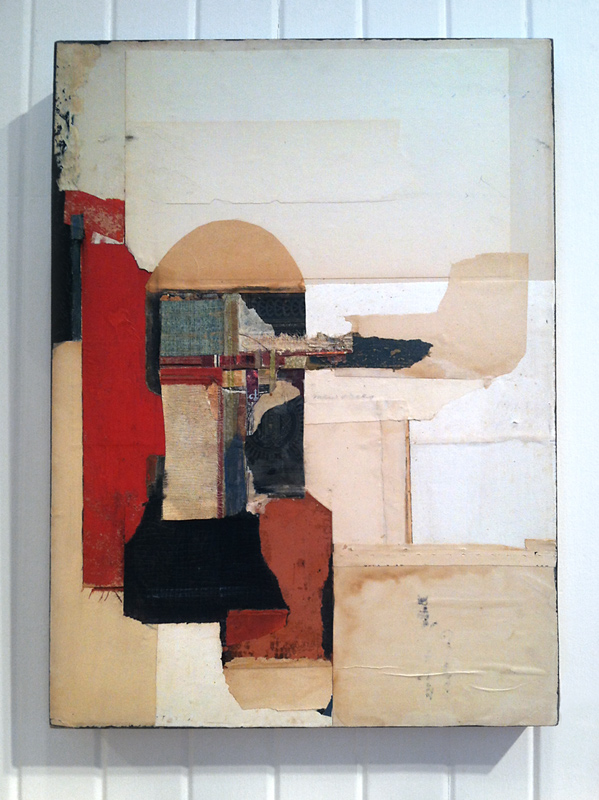
Monteith’s Marrakesh
Teri Dryden
collage from discarded books on panel
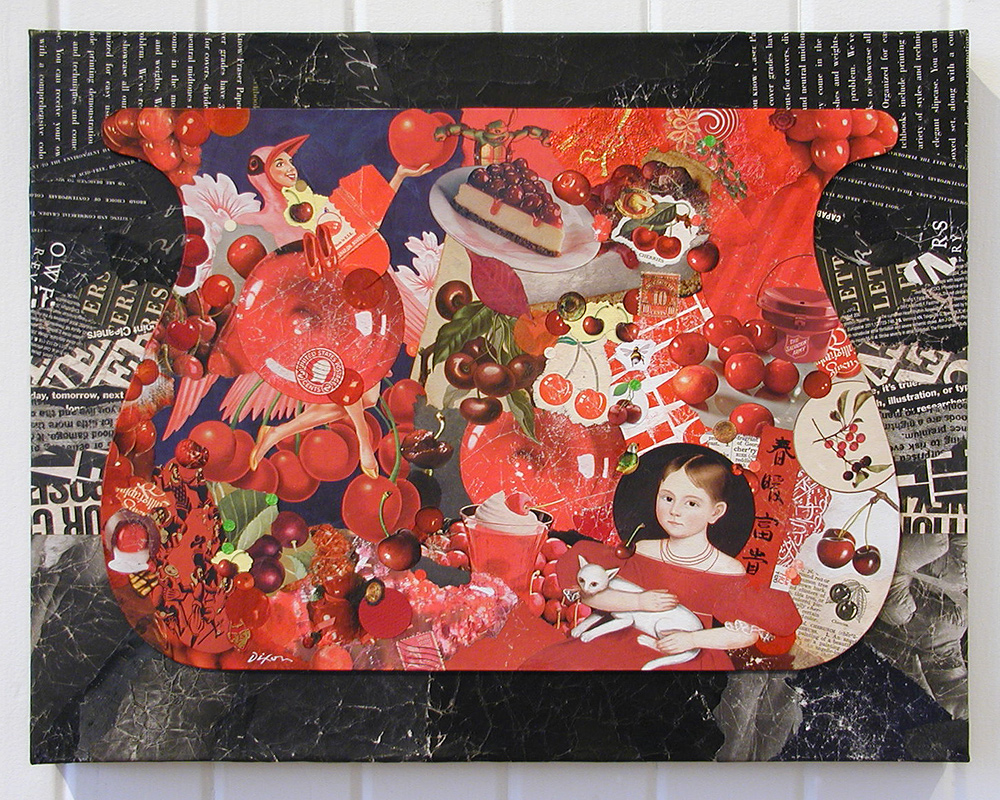
Cherry Balm
John Andrew Dixon
collage on canvas
available for purchase
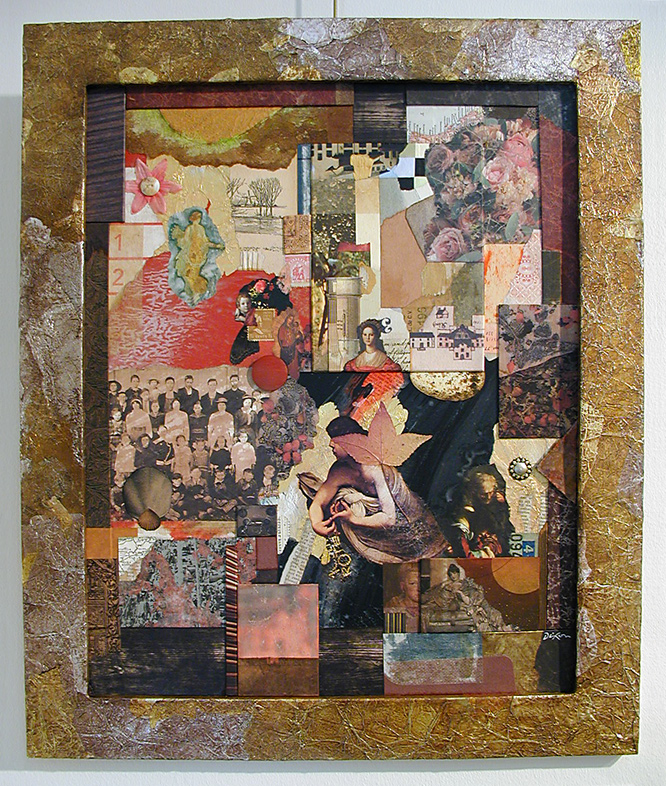
Reliquia
John Andrew Dixon
collage on framed panel
• S O L D
Posted in 1) Available!, Artifacts, Assemblage, B Devlin, B Long, C E Beale, Collaboration, Collage, Dada, Exhibitions, F Otnes, Fruit Series, G Braque, H Höch, Homage, Influences, Ingredients, J A Dixon, J Cornell, J Kolář, K O’Brien, K Schwitters, L Austin, L T Holmes, Larger Works, Layerism, Links, M Duchamp, M Higgins, M Rose, Methodology, P Donley, P Picasso, R H Hunt, R Johnson, Surrealism, T Dryden, T R Flowers, Technique | No Comments »
Monday, June 9th, 2014
“We need a little confusion.”
— Neil Gaiman
The Great American Brass Band Festival’s milestone 25th event is now in the archives. The finale was one of the most satisfying concerts in the history of the Kentucky festival. My appreciation goes to those who made it all happen one more time! I am pleased to have played a small part.
When I was first approached about lending my creative experience to the effort, I pitched the idea of a traditional collage to mark the 25th, using scraps from memorabilia of the last quarter century. A decision was made to go a different direction, but I could not put the idea aside. The result is “Brass 25,” a tribute to my community’s exceptional contribution to the American musical and cultural scene.
Is “commemorative collage” art? Perhaps not. Some might make the case that no example of the medium has approached “high art.” In my opinion, such a viewpoint fails to consider the 100-year impact that the medium has had on our visual landscape and the evolution of our aesthetic perceptions. It neglects the seminal role of Schwitters, Höch, Cornell, Kolář, and others. For me, the core relationship between mundane material and the art of collage transmits a unifying principle. When the remnants of ordinary life are physically re-purposed to resolve a unique compositional harmony, the culminating artifact can achieve a transcendent tone and offer a shared experience with each participating observer. If that is not art, stripped of elitist notions, then what is?
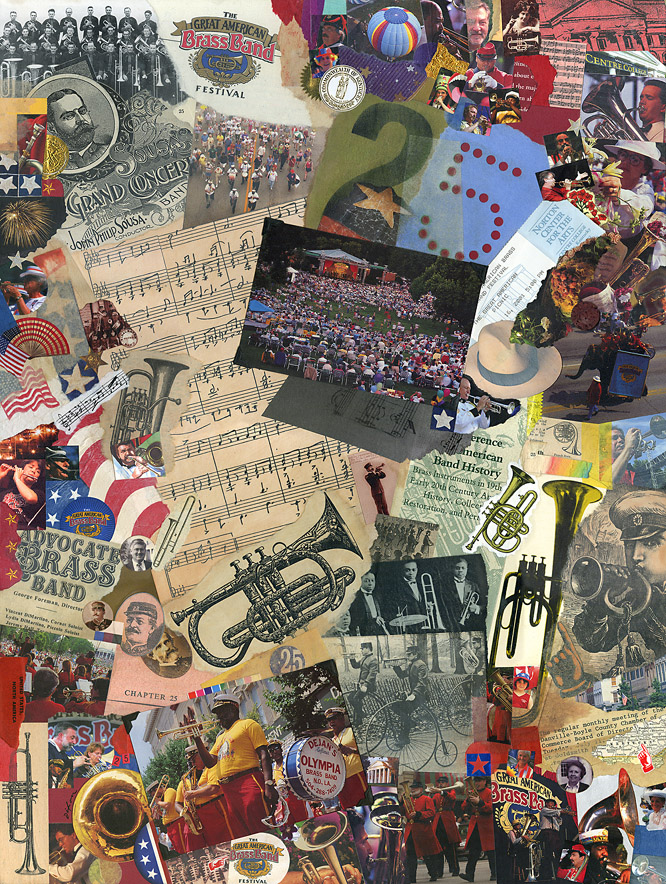
Brass 25
commemorative collage by J A Dixon
17.5 x 23.5 inches
available for purchase
Posted in 1) Available!, Applied Arts, Collage, H Höch, Illustration, Influences, J A Dixon, J Cornell, J Kolář, K Schwitters, Larger Works, Methodology | No Comments »
Friday, July 12th, 2013
“Any fool can carry on, but only the wise man knows how to shorten sail.”
— Joseph Conrad
Looking back on a full year as a blogger, many of my initial objectives have been met, but there are even more subjects to tackle in the coming months. Can I find the right balance between words and images, welcoming others to act as better scribes for what is happening in collage and remembering that I would rather be holding a pair of scissors than typing at a keyboard? The exceptional print quarterly out of Canada, Kolaj, has also celebrated its first birthday. 2012 was the perfect year to salute a century of collage as a modern art and also to look around, assessing the current maturity of the practice. I still have much to say about the pioneers and exemplars — Gris, Schwitters, Hausmann, Höch, Cornell, Hamilton, Johnson — for there is much to observe and absorb about their seminal talismans and bodies of work.
It is equally important to evaluate more of the leading and emerging artists now actively producing what may be known as “post-centennial collage,” perhaps the most vital period of cross-pollinated output in the medium’s history. Where to focus next? Those who magnify the traditions of Dada, Surrealism, Fluxus, or Layerism? Dedicated collage abstractionists such as Touchon, Dryden, Romoff, or Gordon? Masters of the outer reaches of a Maximalist/Minimalist spectrum such as Kroll, Reitemeyer, or De Blauwer? I have for some time lamented the lack of a visual-arts phenomenon equivalent to how musicians have traditionally improvised together, but my recent awareness of dynamic collaborations between collage artists is forcing me to change my mind. Is it time for me to take a closer look at the creative fusions instigated by Collins, Holmes, Daughters, or Wilkin?
My, my . . . have we just laid out another year or more of entries? And I have not yet “scraped the working surface” of all the collage artists who make the contemporary scene so exciting. Do I possess the necessary wisdom to tame my ambitions and “shorten sail?” My mind rebels at the idea that I cannot be an artist and a writer, too. I am no scholar, and some art historians would scoff at my correlations, but I cling to the notion that there is a place for insights about our medium that can come only from a person who faces the same challenges as my working peers when confronting a pile of scrap.
One more thought: As the digital age sweeps over the planet, is there also taking place a not-so-quiet backlash against the erosion of manual dexterity? If so, is there a more compelling counter-trend example than the current explosion of tearing, cutting, assembling, transferring, and pasting? And beyond the familiar “analog” technique, what can be said about the deep influence of visual collage on the preponderance of montage in all things sensory — music, performance, film, and media design? This site can become a place where all of this is explored, discussed, shared, and challenged. Much of that is up to you, valued reader. Meanwhile, I shall continue to see, write, and make more art. Stop by again, soon!
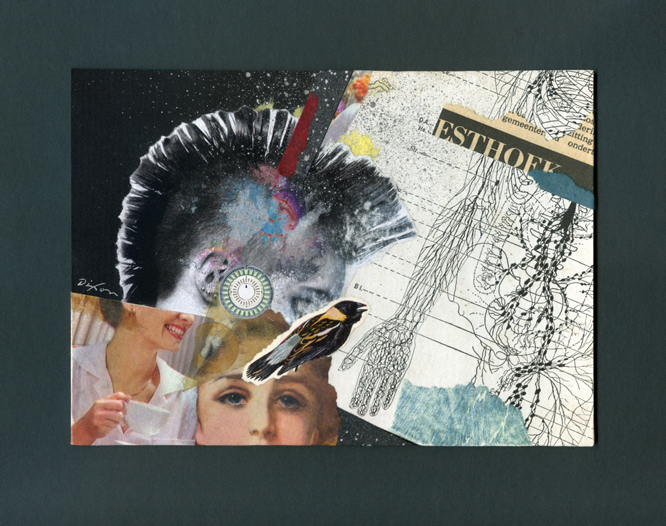
Every Instinct of My Being Rebels
collage miniature by J A Dixon
7 x 5 inches
Purchase this artwork!
Posted in 1) Available!, Artists/Collage, Blog Years, C Touchon, C Wilkin, Collaboration, Collage, D Daughters, Dada, Fluxus, H Höch, H Kroll, I Reitemeyer, Influences, J A Dixon, J Cornell, J Gris, K De Blauwer, K Schwitters, L Romoff, L T Holmes, Layerism, Links, Maximalism/Minimalism, Music, Publications, R Hamilton, R Hausmann, R Johnson, R K Kadour, S Gordon, Surrealism, T Dryden, Z Collins | No Comments »
Saturday, August 25th, 2012
I’m keen on art history to quench a dry spell. Here’s my suggestion to a collage artist in a slump.
• Browse modern art movements that have influenced collage: cubism, dada, constructivism, expressionism, surrealism, pop art.
• Relax and study the seminal masters of the medium: Cornell, Paolozzi, Höch, Hausmann, Schwitters.
• Then go to your “morgue” of images, textures, ephemera, and found material: group various ingredients into piles, responding quickly, intuitively, and without conscious thought for composition or symbolic associations.
• Before you know it, you’ll have more ideas and embryonic projects than you can immediately deal with. React first to the ones that won’t be denied. With a bit of luck, a new series will emerge.
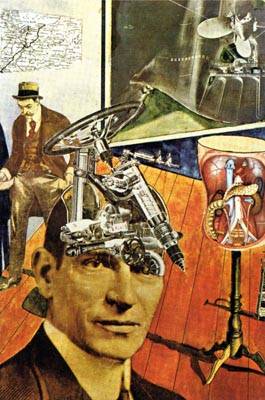
Tatlin at Home
by Raoul Hausmann
1920
Posted in Constructivism, Cubism, Dada, E Paolozzi, Expressionism, H Höch, Influences, Ingredients, J Cornell, K Schwitters, Methodology, Pop Art, R Hausmann, Surrealism | No Comments »
Wednesday, August 1st, 2012
“Books are to be called for and supplied on the assumption that the process of reading is not a half-sleep; but in the highest sense an exercise, a gymnastic struggle; that the reader is to do something for himself.”
—Walt Whitman
When I hear artists say they try to limit their influences, I think, “Nonsense.” Outside of some strange brand of sensory or cultural deprivation, it is simply not possible to avoid influences. That being said, why not regularly go to the masterworks and primary sources for direct, conscious influence to balance or offset the continuous bombardment of visual input from a culture steeped in nth-generation bastardizations? One cannot drive down a street, walk through a shop, or scan the media without being influenced in some way by a legion of art directors, graphic designers, and photographers—and these individuals may or may not have any direct knowledge of how they are re-cycling the ideas of innovative artists. Great writers understand where the basic narrative modes originated. Serious filmmakers know who first did this or that—a dream montage, in-camera trick, or other cinematic effect. One cannot imagine a Morricone who did not know a Beethoven who had never listened to Bach or Haydn. There is no way to conjure up an Emerson who did not know a Montaigne who had never read Lucretius or Diogenes.
The point of this is not to find fault, but to serve as a lead-in for what I intend to be a series of posts about my take on the primary innovators within the evolving medium of collage. Credit must be given to Braque, Picasso, Gris, Duchamp, and others, but, for me, the study must begin with Kurt Schwitters and Joseph Cornell. Any person dedicated to collage who neglects these masters will fail to understand the foundation of the art form. What student hasn’t thrilled to her first startling, Höch-like montage, cut and assembled from discarded magazines? What young person does not, at some point in his creative formation, place a few found objects in a small box, pause to consider the intriguing effect, and not wonder, “Is it art?” Ultimately, what I end up saying here about the key historical figures is far less important than the overwhelming need for you to put your ideas and feelings into context with each one’s remarkable body of work, according to your own perceptions and priorities. For those who encounter their creations for the first time, the inevitable thought will be, “So, he was the first guy to do that…” (except in the case of Höch, of course). Whether one rejects, reveres, ignores, imitates, or “rips off” the great seminal works of collage, one must do so with full awareness. Walt Whitman’s admonishment to writers can equally apply to visual artists. Except for those who approach the medium of collage as a hobbyist, we owe it to ourselves to partake of the “gymnastic struggle.”

Gris | Schwitters | Höch | Cornell
Posted in Artists/Collage, Collage, G Braque, H Höch, Influences, J Cornell, J Gris, K Schwitters, P Picasso | No Comments »
 I’m still feeling a satisfying vibe from one of the most personally rewarding events ever! My hands-on collage workshop was part of the “Train the Trainer“ series in Paintsville, Kentucky for the Johnson County Extension Office. Participating artists intend to share this learning throughout their community in the coming months. My thanks to a fabulous group of creative individuals who were curious about “all things collage” and inspired to “pay it forward” among fellow citizens in their beautiful area of our Commonweath.
I’m still feeling a satisfying vibe from one of the most personally rewarding events ever! My hands-on collage workshop was part of the “Train the Trainer“ series in Paintsville, Kentucky for the Johnson County Extension Office. Participating artists intend to share this learning throughout their community in the coming months. My thanks to a fabulous group of creative individuals who were curious about “all things collage” and inspired to “pay it forward” among fellow citizens in their beautiful area of our Commonweath.






















































